Explore Ride-On Lawn Mowers with Bagging Systems
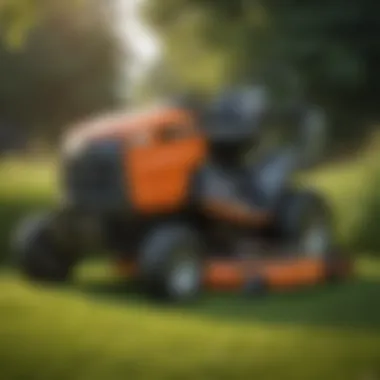
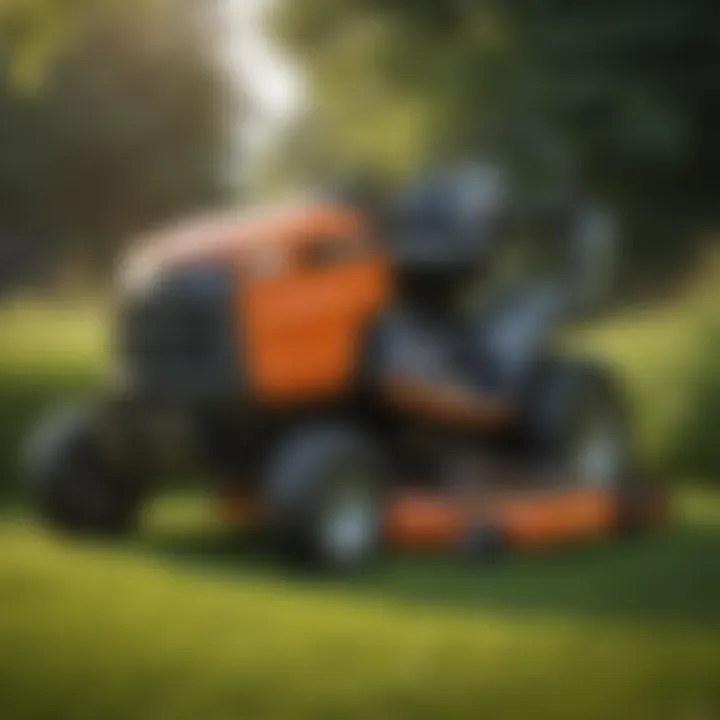
Overview of the Topic
Definition and Importance
Ride-on lawn mowers with bags represent a significant advancement in lawn care machinery. These machines offer a more efficient method for maintaining large grassed areas compared to traditional push mowers. The primary function of these mowers is to cut grass and collect clippings in a bag, reducing the need for raking and disposal. This feature is particularly useful for landscaping professionals and large property owners. Their design allows for ease of use and enhanced productivity, making them an essential tool for serious garden enthusiasts and agricultural workers.
Current Trends
Recent developments in lawn care technology have led to improvements in ride-on mowers. One current trend is the incorporation of eco-friendly options, such as electric ride-on mowers, which aim to reduce carbon emissions and noise pollution. Additionally, manufacturers are focusing on user-friendly features. For example, enhanced ergonomic designs and intuitive controls are becoming common, making these machines accessible for users of all skill levels. Furthermore, innovations in bagging systems, such as increased capacity and better airflow, have optimized collection efficiency.
Key Techniques and Practices
Step-by-Step Guide
To maximize the benefits of a ride-on lawn mower with bags, users should consider the following:
- Preparation: Before mowing, clear the lawn of debris like sticks and stones. This ensures a smoother mowing process and prevents damage to the mower.
- Height Adjustment: Set the mower blade height based on grass type and season. Taller settings are suitable for spring and fall, while shorter cuts can be used during summer.
- Mowing Technique: Start mowing along the perimeter of the lawn, then work your way inward in straight lines. This method ensures better coverage and reduces streaking.
- Bag Maintenance: Regularly check and empty the bag during use. A full bag decreases performance and may cause clumping in the grass.
- End-of-Use Care: After mowing, clean the mower deck to prevent grass buildup, which can lead to rust and inefficiency over time.
Tools and Equipment Needed
Besides the ride-on mower, essential tools include:
- Fuel or battery charger, based on mower type
- Maintenance tools like wrenches and screwdrivers
- Safety gear, such as goggles and gloves to protect against debris
- A grass disposal solution, such as a compost bin or garden waste bags
Challenges and Solutions
Common Obstacles
While using ride-on mowers, users often face challenges such as:
- Mower Stalling: Grass that is too tall can lead to mower overload. This requires users to mow at an appropriate height.
- Uneven Terrain: Steering can be problematic in hilly or uneven areas, risking damage to the mower and injury.
Innovative Solutions
To address these issues, several strategies can be implemented:
- For stalling, a two-pass technique can be effective. First, mow the perimeter to clear the tallest grass, followed by full passes.
- To manage uneven terrain, consider using mowing decks with adjustable heights and stability features that can adapt to ground variability.
Maximizing the use of ride-on mowers with bags depends on understanding both the machine itself and the environment in which it operates. Taking an informed approach to lawn care ensures not only efficiency but also a healthier lawn.
Intro to Ride-On Lawn Mowers
The significance of ride-on lawn mowers lies in their capacity to simplify and enhance lawn care. As areas of grass become larger, the need for more efficient tools becomes paramount. Ride-on mowers offer higher productivity compared to traditional mowers by reducing labor time and providing a uniform cut. This article will delve into what defines ride-on lawn mowers with bagging systems, revealing their strengths, weaknesses, and overall utility in gardening and agricultural practices.
Definition and General Overview
A ride-on lawn mower is a machine designed for cutting grass while the operator sits on it. Typically larger than push mowers, these machines have robust engines that enable them to tackle substantial yard areas efficiently. The addition of a bagging system allows for the collection and disposal of clippings, maintaining a neater lawn. Ride-on mowers usually include features such as adjustable cutting heights and varying blade types to suit different types of grass.
Historical Development
The evolution of ride-on lawn mowers marks significant advancements in lawn care technology. The journey began in the early 20th century when innovative minds sought alternatives to manual mowing. Early models were hand-pushed and lack the speed of modern counterparts. It was not until the 1950s that significant changes occurred with the introduction of gas-powered, self-propelled mowers.
As the decades progressed, manufacturers began to recognize the need for efficiency in larger properties. Thus, ride-on models began to emerge, becoming integral in agricultural and residential settings. The presence of bagging systems became customary during the 1970s as concerns over lawn aesthetics and waste management took precedence. Today, ride-on mowers continue to evolve with technology, integrating features such as electric power and smart controls to enhance user experience and environmental sustainability.
The Mechanics of Ride-On Lawn Mowers
Understanding the mechanics of ride-on lawn mowers is crucial for anyone looking to optimize their lawn care. This section delves into the core elements that contribute to the functionality and efficiency of these machines. By focusing on these components, users can make informed decisions when selecting equipment suited to their needs.
Core Components
The core components of ride-on lawn mowers heavily influence performance and usability. Key elements include engine types, mower decks, and transmission systems. Each component serves a specific purpose and offers distinct advantages.
Engine Types
Engine types are fundamental to the power and performance of ride-on lawn mowers. Common options include gasoline and electric engines. Gasoline engines typically deliver higher horsepower and torque, making them suitable for larger lots and heavy-duty tasks. On the other hand, electric engines tend to be quieter and more environmentally friendly.
One key characteristic of gasoline engines is their ability to operate over long periods without needing a recharge, which is appealing for users with extensive lawns. However, they can also produce emissions, raising environmental concerns.
Conversely, electric engines are often simpler to maintain and do not produce harmful emissions, making them a popular choice among eco-conscious users. Yet, their reliance on battery life can limit range and runtime.
Mower Decks
Mower decks are vital as they determine the width and efficiency of the cutting process. Common deck types include stamped and fabricated decks. Stamped decks are lighter and easier to maneuver, while fabricated decks are more robust and usually offer superior durability.
A key characteristic of mowing decks is their cutting width. A larger width allows for quicker mowing, resulting in significant time savings. However, the increased width can also make maneuvering in tight spaces more challenging.
Furthermore, some mower decks have adjustable heights, adding versatility for users who have to accommodate varying grass lengths. These adjustable features help promote better lawn health, but they may come with an increased complexity in the setup process.
Transmission Systems
Transmission systems are responsible for the control of the mower's movement and speed. Options primarily fall into two categories: manual and automatic. Manual transmissions offer greater control but can be more difficult to operate for some users, particularly those without experience.
Automatic transmissions, such as hydrostatic systems, allow for smoother speed adjustments and easier operation. This feature is particularly beneficial for those who prioritize ease of use, making it an appealing choice for homeowners and less experienced operators.
Each transmission type has its unique set of advantages and challenges. Users should consider the size of their gardens and their comfort level with operating machinery when selecting a transmission system.
Operational Principles
The operational principles of ride-on lawn mowers revolve around their design and intended use. Key components work together to deliver a mowing experience that is both effective and user-friendly. The coordination among engine output, deck design, and transmission efficiency influences the overall mowing outcome.
Utilizing these principles ensures lawns maintain a neat appearance while minimizing physical exertion for the operator. Specific operational features may include cruise control options and ergonomic controls, which further enhance user satisfaction during mowing tasks.
Understanding these mechanisms not only enhances usability but also enables users to troubleshoot any issues that may arise during the lawn care process.
By knowing how the mechanics interact, users can take proactive steps to maintain their equipment, ensuring longevity and reliable operation.
Bagging Systems: An Overview
Bagging systems serve a fundamental role in the functionality and efficiency of ride-on lawn mowers. These systems are primarily designed to collect grass clippings, leaves, and other debris as the mower operates. Their significance is highlighted in maintaining a tidy lawn and contributing to overall lawn health. A well-functioning bagging system can reduce the need for subsequent lawn maintenance tasks, making it a sought-after feature among both professionals and avid gardeners.
Understanding the components and technology behind bagging systems is essential for any user. It aids in selecting the right mower that meets specific needs and preferences. Moreover, the efficiency of these systems directly affects the mowing experience. Users should be aware of various bagging technologies available, as each comes with unique advantages and disadvantages. This knowledge allows for more informed decision-making regarding purchases and maintenance.
Understanding Bagging Technology
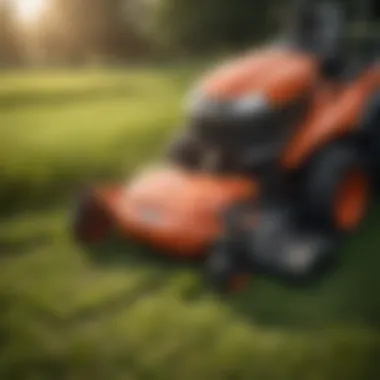
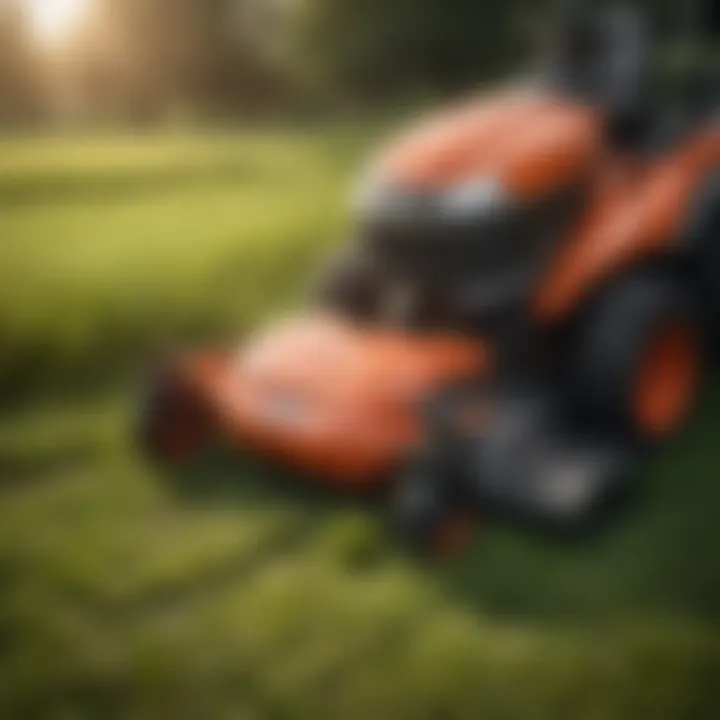
Bagging technology has advanced significantly over the years. Modern mowers utilize sophisticated systems that ensure effective grass collection while optimizing engine performance. Essentially, these technologies work by channeling clippings into bags with minimal escape, reducing litter on the lawn and providing a cleaner look. Some bagging systems come equipped with features that allow for effortless emptying of debris collection.
In addition to efficiency, many of these systems include features for ease of use, making maintenance tasks simpler. The technology behind bagging has proven beneficial for lawn health, as it encourages regular grass collection that reduces thatch build-up and promotes healthier growth.
Types of Mower Bags
Ride-on lawn mowers offer various types of bags, each catering to distinct needs and preferences. Understanding these different types can help in selecting the best option for your lawn care tasks.
Hard Shell Bags
Hard shell bags are designed for durability and structural integrity. Their primary characteristic is a rigid frame that helps maintain shape, preventing clogging during use. This design is beneficial for extensive mowing tasks, particularly in areas with thick or dense grass.
The unique feature of hard shell bags is their capacity. They often hold more clippings than soft options, requiring less frequent emptying. However, their rigid structure can make them heavier and less flexible, which might be a disadvantage when emptying or storing. This means users should consider the ease of handling during operation.
Soft Fabric Bags
Soft fabric bags are popular among users looking for flexibility and lightweight options. Made from breathable materials, these bags allow for better airflow which can prevent damp clippings from accumulating. They are usually lighter than hard shell bags, making them easier to maneuver and empty.
The core characteristic of soft fabric bags is their compactness. They can fold down for easy storage, which is advantageous for users with limited space. However, they may have a smaller capacity compared to hard shell types, leading to more frequent emptying during extended mowing sessions. Additionally, they are prone to wear and tear, particularly in rough conditions.
Integrated Systems
Integrated bagging systems combine the mower's design and operating mechanisms. These systems are built into the mower engine, leading to a streamlined functionality. The key characteristic of integrated systems is their efficiency; they can handle debris without the need for separate bagging.
A significant advantage of integrated systems is that they offer users a more compact and lighter option. They reduce the number of parts that need to be maintained or replaced. However, the downside is that repairs can be more complicated because of the internal structure. Users must weigh the ease of use against potential maintenance issues when considering integrated systems.
Advantages of Ride-On Lawn Mowers with Bags
When contemplating the benefits associated with ride-on lawn mowers equipped with bagging systems, it’s essential to consider various factors that provide practical advantages. These mowers are not merely tools for cutting grass; they enhance the overall lawn care experience for users. Understanding these advantages can aid users in making an informed choice for their lawn maintenance needs, especially within the context of efficiency, lawn health, and usability.
Efficiency and Time-Saving
One of the foremost advantages of ride-on lawn mowers with bags is their efficiency. The capacity to cover large areas quickly is a significant benefit, especially for those maintaining sizable lawns. The wide cutting decks generally equipped on these models reduce the total mowing time. In addition, the onboard bagging systems collect grass clippings, eliminating the need for secondary clean-up tasks. This dual function saves users both time and effort, allowing them to focus on other important activities during the mowing season.
Moreover, the efficiency extends beyond mere time saved. These mowers often come with features that facilitate better maneuverability and control. For instance, some models include tighter turning radii, enabling users to navigate around flower beds and trees with ease. This aspect is particularly advantageous for homeowners who value a tidy lawn with reduced damage to landscaped areas.
Improved Lawn Health
The design of ride-on lawn mowers with bagging systems also promotes improved lawn health. By collecting grass clippings, users can prevent excessive thatch buildup. Thatch, the layer of dead grass and organic debris, can suffocate the lawn and hinder healthy grass growth. Regular use of bagging mowers can mitigate this issue, resulting in a healthier lawn.
In addition, removed clippings can be composted or used in garden beds, providing nutrients back into the ecosystem. This process emphasizes sustainable gardening practices, making these mowers appealing not just for aesthetics, but also for fostering a robust lawn environment.
Ease of Use
Ease of use is a hallmark of ride-on lawn mowers with bags. Many models come equipped with user-friendly controls, making them accessible for a broader audience. Features such as simple ignition systems and adjustable cutting heights can enhance the experience for both seasoned lawn care professionals and home gardeners.
Additionally, the riding aspect of these mowers reduces physical strain on the user. Rather than pushing a heavy walk-behind mower, operators can sit comfortably while steering the mower, making the process less cumbersome. This is especially relevant for individuals who may have mobility issues or those who simply prefer a less physically demanding option.
"The convenience of a ride-on mower can transform the tedious task of lawn care into a more enjoyable experience."
Disadvantages and Challenges
When considering ride-on lawn mowers with bags, it is crucial to understand their disadvantages and challenges. Such an understanding contributes to making informed decisions about whether these machines meet specific lawn care needs. Despite offering numerous benefits, these mowers also present limitations that can affect their overall practicality and user experience.
Cost Considerations
One of the most significant challenges of owning a ride-on lawn mower with a bagging system is the initial cost. These machines can represent a sizeable financial commitment. Prices vary widely depending on brand, features, and overall capacity. Advanced models with high engine power and sophisticated bagging technology typically cost more.
Additional costs may arise from maintenance, repairs, and replacement of worn-out parts. It is essential to evaluate whether the investment aligns with your budget and expected return on investment. Purchasing used models can help curb costs, but buyers must carefully inspect the equipment's condition.
- Considerations:
- Evaluate features and decide on necessary power level.
- Research different brands and compare their pricing.
- Factor in long-term operational and maintenance costs.
Maintenance Needs
Maintenance is another critical aspect of using ride-on lawn mowers. Bagging systems introduce the requirement for regular care beyond what is needed for standard mowers. Users must ensure the bagging components are in good working order, which includes checking for clogs and cleaning them thoroughly after use.
Routine checks should also extend to engine performance, blades, and tire conditions. Neglecting these aspects can lead to decreased efficiency and potentially costly repairs. Users should designate time for these tasks in order to prolong the mower's lifespan and maintain its effectiveness.
Storage and Space Requirements
Storage is a practical consideration that can often be overlooked. Ride-on lawn mowers with bagging systems require more space than traditional push mowers. A designated area that can accommodate their larger size is necessary.
In many cases, users may need to invest in a shed or garage to keep these machines safe from the elements. Additionally, if you own multiple lawn care tools, planning for sufficient storage space becomes even more vital. This aspect may seem trivial, but it can significantly impact one’s overall experience with the equipment.
"Understanding the stacked disadvantages of owning a ride-on lawn mower with a bagging system can lead to more satisfied ownership and better investment decisions."
In summary, while ride-on lawn mowers with bags provide numerous advantages, the disadvantages and challenges associated with cost, maintenance, and storage cannot be overlooked. A careful evaluation of these factors is pivotal for anyone considering the purchase of such equipment.
Key Features to Consider When Purchasing
When selecting a ride-on lawn mower with a bagging system, several critical features require careful consideration. Choosing the right model can significantly impact your lawn care experience. Each element contributes to efficiency, ease of use, and overall performance. Here are the essential features to focus on:
Cutting Width and Adjustability
The cutting width of a lawn mower is vital. It determines how much grass is cut in one pass. A wider cutting width can save time but may be less maneuverable. Adjustability is also important. Many models allow you to change cutting heights, accommodating different grass types and conditions. This flexibility ensures a tailored mowing experience, promoting a healthy lawn. Consider models like the Husqvarna YT4V48 or the Cub Cadet XT1 that offer these adjustable features.
Engine Power and Performance
Engine power affects the mower's ability to tackle dense grass and uneven terrain. A powerful engine translates to better performance, particularly during intense mowing sessions. Look for models with higher horsepower ratings, generally offering faster speeds. Additionally, consider the type of engine. Gas engines typically provide more power but require more maintenance. Battery-powered models like the John Deere 48V electric mower are quieter and often more eco-friendly. Evaluating engine performance ensures you choose a model suitable for your yard's demands.
Bag Volume and Efficiency
Bag volume matters a lot for efficiency and convenience. A larger bag reduces the number of times you need to stop and empty it. Models with higher capacity can handle more clippings before necessitating an emptying. Efficiency also depends on how well the bagging system captures grass. Poorly designed bags can lead to clumping and overflow, negating efficiency benefits. Look for systems that provide clear indicators for when bags need emptying, which can save you time during mowing. Brands such as Snapper or Ryobi provide commendable options in this regard.
It's imperative to assess your lawn's specific needs while selecting the features of a ride-on mower with bags. Not every mower suits every lawn type, so target the specifications that align best with your unique mowing requirements.
Exploring these three key features thoroughly can help you make an informed purchase. By understanding the nuances between cutting width, engine power, and bag volume, you will optimize your lawn care tasks effectively. Selecting the right model enhances your overall satisfaction with the ride-on lawn mower.
Environmental Impact
The importance of environmental impact in the context of ride-on lawn mowers with bags cannot be overstated. As more individuals and businesses focus on sustainable practices, understanding how these machines affect the environment becomes crucial. This section examines emissions, sustainability aspects, and the comparison of mulching versus bagging, providing deeper insights into ecological considerations in lawn care.
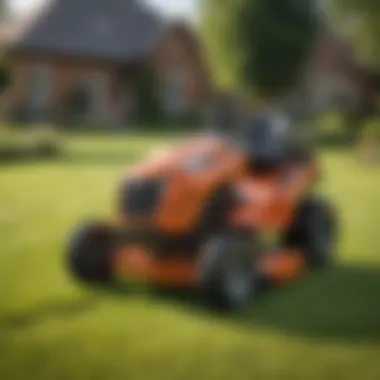
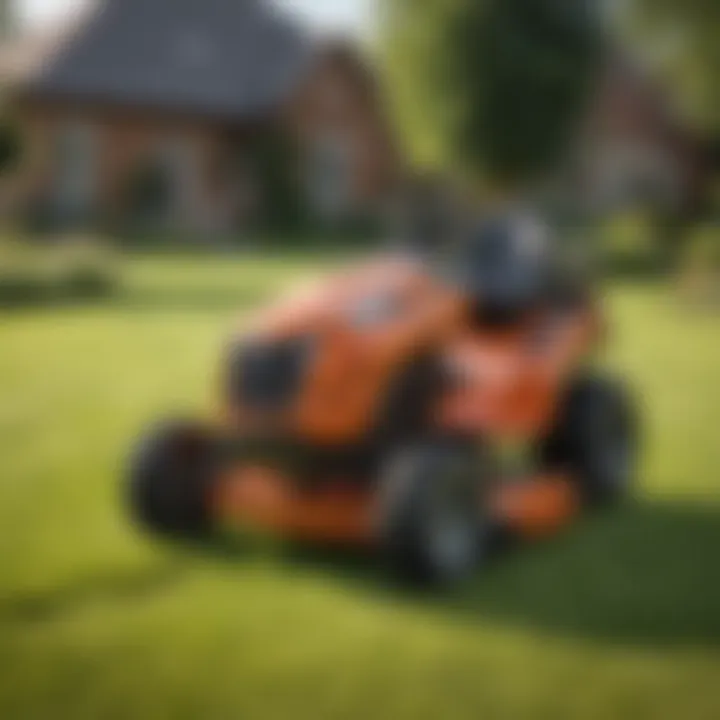
Emissions and Sustainability
Ride-on lawn mowers, like any gasoline-powered equipment, produce emissions that can contribute to air pollution. Significant sources of these emissions include carbon monoxide, nitrogen oxides, and particulate matter. In the quest for sustainability, many manufacturers are developing engines that meet more stringent emission standards. For instance, models equipped with electric engines often produce zero emissions during operation, making them a superior choice for environmentally conscious consumers.
Moreover, using ride-on mowers equipped with efficient bagging systems can enhance sustainability. Collecting grass clippings not only keeps the lawn tidy but also minimizes the need for additional fertilizers. Clippings can be composted or mulched to return nutrients to the soil, which reduces reliance on chemical inputs.
Those interested in sustainable mowing should consider the following:
- Choosing electric models that minimize emissions.
- Researching manufacturers that adhere to eco-friendly practices in production.
- Utilizing grass clippings effectively to maintain lawn health while reducing waste.
"The transition to more sustainable mower technologies represents a significant step towards reducing the environmental footprint of landscaping practices."
Mulching vs. Bagging
The debate between mulching and bagging is essential for maximizing the environmental benefits of lawn care. Mulching involves finely cutting grass clippings and returning them to the lawn. This practice improves soil health, as grass clippings decompose quickly, providing nutrients back to the soil. It creates a natural recycling system, which can lead to improved moisture retention and reduced need for artificial fertilizers.
On the other hand, bagging grass clippings can also be beneficial. While it promotes a cleaner appearance, it prevents clippings from returning to the soil. However, collecting clippings allows for composting, which can help in creating nutrient-rich soil amendments. The choice between these methods may depend on specific lawn conditions and personal preferences.
Here are a few considerations:
- Mulching benefits: Reduces waste, enhances soil health.
- Bagging advantages: Provides a cleaner look, allows for composting.
- Personal choice: Base your decision on lawn maintenance habits and environmental goals.
Understanding these elements vitalizes the conversation around sustainable lawn care practices. Keeping emissions low while efficiently managing grass can lead to a more sustainable approach to lawn maintenance.
Technological Innovations in Lawn Care
Technological advancements continue to reshape the landscape of lawn care. In this section, we will examine how these innovations have a direct impact on ride-on lawn mowers equipped with bagging systems. The integration of technology not only enhances performance but also addresses the growing needs for efficiency and environmental sustainability. Understanding these innovations allows users to make better choices in their lawn care equipment.
Smart Mowers and IoT Integration
Smart mowers represent a significant leap in the world of lawn care. Equipped with IoT (Internet of Things) features, these mowers allow users to control and monitor their device remotely.
Some key aspects include:
- Remote Access: Users can operate their mowers from smartphones or tablets, granting flexibility in mowing schedules.
- Data Collection: These mowers can gather data about lawn conditions and provide insights for optimized mowing patterns.
- Automation: They can automatically adjust cutting heights based on grass length, ensuring a uniform cut with minimal effort.
The convenience provided by these smart devices leads to better management of time and resources. Moreover, IoT integration facilitates reminders for maintenance and alerts in case of potential issues.
"Smart mowers are not just a luxury; they are becoming a necessity for high-efficiency lawn care."
Robotic Lawn Mowers
Robotic lawn mowers are another remarkable innovation that is gaining popularity. These autonomous devices operate without direct human intervention. They navigate lawns using sensors, creating an efficient mowing route. Some of their advantages include:
- Autonomous Operation: Users can set schedules, and the mower takes care of the rest, improving convenience.
- Safety Features: Built-in sensors help prevent accidents by stopping the mower when an object is detected.
- Eco-Friendly Design: Many robotic mowers use electric power, reducing emissions compared to gas-powered equipment.
While they might require initial investment, the long-term benefits, such as reduced labor costs and improved lawn health, can outweigh these costs. The advancements in robotic technology ensure an ever-improving performance, making them an appealing option for lawn care enthusiasts.
Maintenance Tips for Ride-On Lawn Mowers
Proper maintenance of ride-on lawn mowers is vital for their longevity and performance. Just like any complex piece of machinery, neglect can lead to poor operation and costly repairs. Regular maintenance not only ensures that the mower runs efficiently but also enhances safety. Keeping up with maintenance tasks may seem arduous, but doing so provides significant benefits in reducing downtime and increasing the lifespan of the mower. The following sections delve into essential routine checks and specific winterization procedures that can help agricultural professionals and gardening enthusiasts alike.
Routine Checks and Care
Conducting routine checks on a ride-on lawn mower is crucial. These checks ensure all components function correctly and safely. Here are some important aspects to consider during routine maintenance:
- Oil Levels: Regularly check and change the oil as part of routine maintenance. Clean oil is essential for lubricating parts and preventing overheating.
- Air Filter: Inspect the air filter frequently. A clogged air filter can reduce engine efficiency and increase fuel consumption.
- Spark Plug: Check the spark plug condition regularly. Replacing a worn spark plug can significantly enhance engine performance.
- Blades: The mower blades should be sharpened after every 20-25 hours of use. Sharp blades cut grass more cleanly, promoting healthier lawn growth.
- Battery Maintenance: Ensure the battery is adequately charged and clean the terminals to prevent corrosion.
- Fuel System: Use fresh fuel and keep the fuel system clean to ensure optimal performance. Old, stale fuel can lead to starting issues and reduced power.
By following these checks, not only can you improve performance, but it also fosters a reliable mowing experience.
Winterization Procedures
Winterizing a ride-on lawn mower is a key procedure to protect it during off-seasons. Special attention is needed to prevent damage from cold weather or moisture buildup. Here are crucial steps in the winterization process:
- Thorough Cleaning: Before storing for winter, clean the mower thoroughly. Remove any grass clippings, mud, and debris to prevent mold and corrosion.
- Drain Fuel: Stale fuel can lead to many issues. It is best to drain all fuel from the tank and carburetor or add a fuel stabilizer to keep it fresh.
- Check Battery: Remove the battery and store it in a cool, dry place. Make sure to charge it every few months during the winter.
- Lubrication: Lubricate moving parts as indicated in the user manual. This prevents rust and keeps everything running smoothly.
- Cover the Mower: Use a breathable cover to protect it from dust and moisture. Avoid damp covers, as they can trap moisture underneath.
Winterizing your mower properly can save you time and money in repairs the following spring.
Failing to winterize adequately can lead to significant issues, including engine failure in the new season. By following the above routines and winterization practices, you ensure that your ride-on lawn mower remains in excellent condition for the long haul.
Common Issues and Troubleshooting
Common problems with ride-on lawn mowers can significantly affect their performance and efficiency, making troubleshooting an essential skill for users. Recognizing these issues early can save time and money, ultimately prolonging the mower's lifespan. This segment tackles prevalent engine and transmission difficulties faced by users, providing valuable strategies for diagnosis and resolution. Understanding these topics is crucial for agricultural professionals and gardening enthusiasts who rely on these machines for effective lawn care.
Engine Problems
Engine issues are among the most common complaints with ride-on lawn mowers. Users may notice symptoms such as difficulty starting, irregular engine noises, or stalling during operation. These problems often stem from various underlying causes. Regular maintenance is crucial for preventing engine troubles.
Key considerations include:
- Fuel Quality: Poor-quality or old fuel can lead to engine performance issues. Always use fresh gasoline with the necessary octane ratings.
- Air Filter Condition: A blocked or dirty air filter restricts airflow, making it difficult for the engine to breathe. Regularly check and clean or replace the air filter as needed.
- Spark Plug Issues: Worn or dirty spark plugs can cause misfiring. Inspect and change them periodically to ensure smooth operation.
If an engine fails to start, a systematic approach to checking the fuel system, electrical components, and mechanical parts can often illuminate the problem. For more guidance on troubleshooting, consider looking at user forums on platforms like reddit.com.
Transmission Failures
Transmission problems can result in a loss of power or difficulty in maneuvering the mower, creating obstacles in lawn care tasks. Various factors contribute to these issues, making it vital to understand the transmission system's workings.
Common signs of transmission failure include:
- Inability to Change Gears: If the mower struggles to shift gears, this may indicate a problem with the transmission fluid or a mechanical failure within the transmission itself.
- Slipping Gears: If the mower appears to change gears on its own during operation, it may require inspection of the drive belt or related components.
- Excessive Vibration: A vibrating mower during operation can signal misalignment within the transmission assembly.
Addressing transmission troubles involves checking fluid levels, inspecting belts, and ensuring proper alignment. Regular inspections and maintenance can prevent serious transmission issues, thereby enhancing operational efficiency.
By proactively managing common issues, ride-on lawn mowers can perform effectively, ensuring that mowing tasks are completed smoothly and efficiently.
Comparative Analysis with Other Lawn Care Equipment
Understanding the differences between various lawn care equipment is crucial for proper decision-making in lawn maintenance. This section discusses the unique aspects and functional attributes of ride-on mowers as compared to other equipment like lawn tractors and walk-behind mowers. Each type has its own strengths and weaknesses, affecting performance, ease of use, and overall efficiency in maintaining a healthy lawn.
Lawn Tractors vs. Ride-On Mowers
Lawn tractors and ride-on mowers serve similar purposes but cater to different needs. Lawn tractors are typically designed for larger areas. They often feature more powerful engines, longer cutting decks, and enhanced capabilities for handling attachments. Meanwhile, ride-on mowers are more compact. They are often easier to maneuver in tighter spaces and provide better control on uneven terrain.
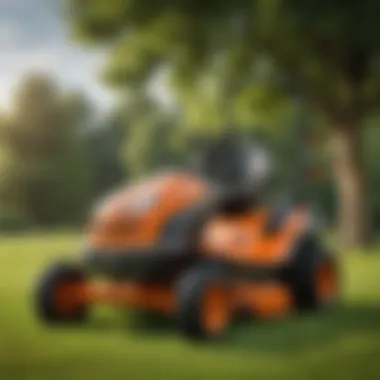
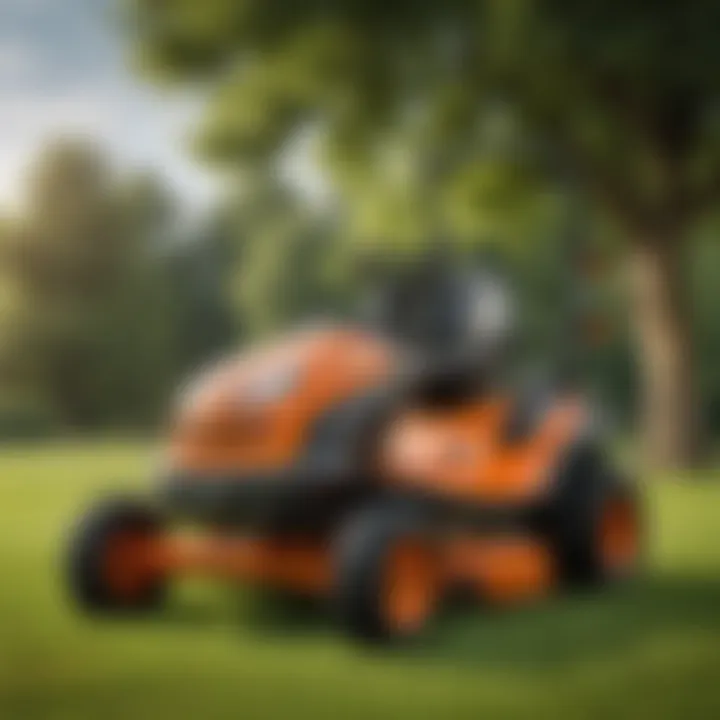
When considering a choice between lawn tractors and ride-on mowers, several factors come into play:
- Power: Lawn tractors generally have larger engines that can handle tougher tasks. They can tow heavy attachments like aerators or seeders.
- Capacity: If you have a larger property, the wide-cutting decks of lawn tractors may be more efficient.
- Maneuverability: Ride-on mowers can navigate through narrow paths more easily.
Ultimately, the decision depends on yard size and specific needs. If you prioritize power and durability, a lawn tractor may be the better choice. However, for smaller lawns or more delicate care, a ride-on mower excels.
Walk-Behind Mowers vs. Ride-On Mowers
Walk-behind mowers and ride-on mowers are two distinctly different options aimed at various types of consumers and landscapes. Walk-behind mowers are often favored for smaller lawns, offering easier storage and lower price points. They require more physical effort and engagement from the user.
Here are some considerations when comparing these two types:
- Physical Effort: Walk-behind mowers demand significant manual labor. They require pushing, which can become tiresome, especially over large areas.
- Cost: Generally, walk-behind mowers are less expensive than ride-on models. This can be an essential factor for those with a limited budget.
- Efficiency: Ride-on mowers allow for quicker and more efficient mowing, as they cover more ground in less time.
"Choosing the right mower depends not only on size but also on how much effort you want to exert during the mowing process."
To summarize, the choice between walk-behind and ride-on mowers depends significantly on the area to be mowed and personal preferences regarding physical exertion and storage capacity. Understanding these comparisons can guide users in selecting a mower that best fits their needs.
User Experiences and Reviews
User experiences and reviews play a critical role in understanding the effectiveness of ride-on lawn mowers with bags. These insights provide real-world perspectives that manufacturers' specifications often overlook. Therefore, this section delves into the relevance and impact of user feedback on potential buyers and current users alike.
Feedback from actual users can highlight specific advantages or drawbacks found during operation. This information is valuable, as it can influence purchasing decisions. Prospective buyers gain a more nuanced perspective of the models on the market, enabling them to choose a mower that aligns with their needs and expectations. Additionally, user reviews may expose recurring issues with specific models, which can impact long-term satisfaction and maintenance planning.
Moreover, user experiences help in identifying trends related to performance, reliability, and maintenance. These insights often cover areas such as ease of use, comfort, and overall mowing efficiency. Thus, reading multiple reviews can offer a holistic view that may not be captured through technical specifications alone.
User Satisfaction Ratings
User satisfaction ratings typically reflect a combination of features, performance, and overall value. Most lawn mower reviews include star ratings or numerical scores, allowing for a quick comparison between different models. High satisfaction ratings often correlate with a combination of effective bagging systems, engine performance, and enhanced features like comfortable seating and intuitive controls.
It is essential to consider these ratings in context. For instance, a mower may receive high marks for cutting quality but may fall short in comfort. Users might mention the mower's ability to collect grass clippings efficiently but may express disappointment in its fuel consumption. Therefore, understanding satisfaction ratings requires looking beyond the numbers to read about the user's experience with that particular product.
- Key Metrics to Consider When Evaluating Ratings:
- Common Themes in User Reviews:
- Overall performance (cutting quality, bagging efficiency)
- Ease of use and control
- Maintenance requirements
- Positive comments on maneuverability and compact design
- Negative feedback often centered around poor bagging or engine issues
Case Studies of Specific Models
Analyzing specific case studies provides deep insights into the practical use of ride-on lawn mowers with bags. Here, we can highlight real-world feedback on notable models available in the market.
One such model is the Cub Cadet XT1 Enduro Series. Users often praise its cutting performance and its efficient bagging system. Many are impressed with its robust engine, providing enough power to tackle larger lawns without strain. However, some reviews indicate challenges with mulch capability, suggesting that while bagging is efficient, mulching may not meet expectations.
Another example is the John Deere X350. This model generally receives high user satisfaction due to its build quality and ease of operation. Users highlight the comfort level during extended mowing sessions, which can significantly influence overall satisfaction. However, a few customers raise concerns about its higher initial cost, suggesting that while it delivers on performance, budget-conscious consumers might seek alternatives.
"User reviews tell us the real story of a mower's performance; they reveal what is not mentioned in the manual."
Each model's performance varies based on individual experiences. Therefore, reading about multiple cases can guide decisions effectively. By evaluating successful and unsuccessful case studies, potential buyers can learn which mower suits their unique requirements best. This approach ensures a more informed purchase, aligned with realistic expectations.
Future Trends in Lawn Care Technology
The future trends in lawn care technology are crucial for the evolution of ride-on lawn mowers with bagging systems. As the demands for efficiency, sustainability, and ease of use increase, manufacturers are focusing on integrating innovative technologies into their designs. This shift not only optimizes lawn maintenance but also aligns with environmental concerns, offering smarter solutions for both professionals and enthusiasts alike.
Emerging Features in New Models
New models of ride-on lawn mowers are increasingly equipped with cutting-edge features. Some of these emerging technologies include:
- GPS Navigation: This technology helps to improve the precision and accuracy of mowing patterns. It reduces overlap and missed spots, ensuring a more uniform cut.
- Smart Sensors: Sensors monitor grass height and adjust the mowing speed or cutting height accordingly. This leads to efficient energy use and better lawn health.
- Connectivity: Many modern mowers now connect to smartphones or tablets. This allows users to track performance, receive maintenance alerts, and control settings remotely.
- Autonomous Functionality: Some models are incorporating self-driving capabilities, making it possible to mow the lawn with minimal human intervention. This is particularly appealing for large areas.
The integration of these features highlights a significant shift towards automation and user-friendly interfaces, promoting enhanced operational efficiency.
Potential Market Developments
The market for ride-on lawn mowers is poised for dynamic changes in the coming years. Several developments are likely to influence the industry:
- Increased Demand for Eco-Friendly Options: As environmental awareness grows, consumers seek lawn mowers that minimize emissions and energy consumption. Manufacturers are responding by offering electric models with bagging systems.
- Competition Among Brands: Established brands are continuously enhancing their product lines to maintain market share. This competition drives innovation and often results in better features at competitive prices.
- Expansion of Distribution Channels: Online retailing has become more prevalent, allowing consumers easier access to a wider range of products. This change is likely to spur growth in the market.
- Focus on Customer Experience: Manufacturers will increasingly prioritize user satisfaction, leading to more intuitive designs and responsive customer service.
The intersection of these developments will likely shape the future landscape of lawn care, making it more efficient and environmentally sustainable.
Cost Analysis: Return on Investment
Evaluating the cost of ride-on lawn mowers with bagging systems goes beyond their purchase price. It involves an assessment of various factors that relate to their efficiency, longevity, and overall utility. The investment must be viewed in the context of both immediate costs and long-term benefits.
Evaluating Costs versus Benefits
When considering a ride-on lawn mower, initial costs are crucial yet do not encapsulate the entire financial picture. The benefits provided by these machines can justify a higher upfront price. Here are some elements to consider:
- Purchase Price: Different models vary significantly. Higher-end mowers may seem expensive but often offer better durability and efficiency.
- Maintenance Expenses: Regular maintenance is vital for longevity. However, some models may require more upkeep, thus raising long-term costs.
- Fuel Efficiency: The type of engine and technology can impact fuel consumption. Mowers that operate more efficiently can save money in the long run.
- Time Savings: A ride-on mower can dramatically reduce the time spent on lawn care compared to manual options. This efficiency translates into a higher value of use over time.
A comprehensive analysis of costs and benefits is critical to making an informed decision. Saving money in one aspect may lead to higher expenses in another.
Financing Options and Budgeting
Considering financing can ease the burden of upfront costs. Various options allow consumers to choose what suits their financial situation:
- Installment Plans: Many retailers offer installment payments spread over several months or years. This option allows buyers to afford higher-priced models without overwhelming financial strain.
- Low-Interest Financing: Some manufacturers have partnerships with financial institutions to offer low-interest financing options, making payments more manageable.
- Budgeting Tools: Using budgeting tools can help track monthly expenses related to lawn care. Setting aside a specific amount each month can create a fund strictly for maintenance and repairs.
When planning for the total costs:
- Allocate funds for seasonal maintenance, fuel, and any unexpected repairs.
- Consider warranties and insurance as part of the budgeting process.
End and Recommendations
The section on Conclusion and Recommendations is pivotal as it encapsulates the key takeaways from the entire guide. It serves to reinforce understanding and application of ride-on lawn mowers equipped with bags. Through this final part, readers are invited to assess the information presented and align it with their needs and aspirations in lawn care.
Summary of Key Insights
In summation, ride-on lawn mowers with bagging systems present a multitude of advantages over traditional mowing methods. Here are some essential insights to carry forward:
- Efficiency: These mowers significantly reduce time spent on lawn maintenance. The ability to bag grass clippings means fewer trips to waste disposal areas, which enhances overall productivity.
- Lawn Health: Regular bagging helps prevent lawn diseases by removing clippings that can harbor pests and pathogens. A well-maintained lawn contributes not only to aesthetics but also to a healthier ecosystem.
- Technological Integration: The rise of smart mowers and IoT integration showcases an evolution in lawn care technology, allowing users to operate machinery remotely and monitor performance metrics efficiently.
- Cost-Benefit Analysis: Despite a higher initial investment, the long-term savings on maintenance and evaluation of enhanced property value can justify the expense of these mowers. It is crucial to consider lifetime ownership costs versus immediate pricing when making purchase decisions.
Final Thoughts on Usage
The utility of ride-on lawn mowers with bags extends beyond simple mowing tasks. They represent a blend of practicality and technological advancement, making them increasingly relevant for both the modern homeowner and agricultural professionals.
In using these machines, consider:
- Selecting the Right Model: Different models offer varied performance characteristics. Evaluate cutting width, engine power, and bag efficiency based on your lawn’s size and terrain.
- Consistent Maintenance: Regular checks and maintenance will ensure the longevity and efficiency of the mower. This includes changing oil, cleaning the mower deck, and checking the bagging system for clogs.
- Environmental Considerations: Be aware of emissions, and opt for options that support sustainable practices. Some models may provide mulching features, allowing users to enhance organic matter return to the soil.
Ultimately, aligning the choice of mower with specific gardening needs enables better lawn care management. Adjusting lawn maintenance practices to utilize the full potential of ride-on mowers ensures both optimal results and satisfaction.



